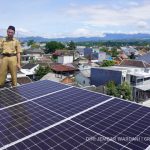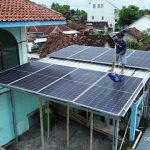Jakarta (Greeners) – Botanical garden development in Indonesia is aiming to provide services in education, conservation, conservation, recreation, and refreshing space from urban routines. Indonesian Botanical Garden Foundation (YKRI) has been encouraging to extend the roles of botanical gardens in Indonesia, for not just limited to research purposes.
Deputy head of YKRI, Sonny Keraf, said that current condition of Indonesia’s botanical gardens have yet to be compared to foreign botanical gardens. He cited botanical garden in England which also serves as educational tool. Keraf said that the roles would be main focus of YKRI.
“I am not sure if Indonesia’s botanical gardens are similar. But, in the future, we are planning to cooperate with schools as educational spot. If possible, the schools would visit [botanical gardens] once a week to increase environmental awareness. This is concrete [steps] and not text book,” said Keraf to Greeners, in Jakarta, on Thursday (16/2).
READ ALSO: Biodiversity Requires All Stakeholders’ Support
Apart from educational aim, recreation becomes another focus developed by YKRI.
Keraf said that global economy will be based on spare-time economy, which means work driven people would look out for balance or recreational spots. It serves as refreshing tool, to manage their inner waste which damage mentally and psychologically,” he said. “That’s where botanical garden can play the role as one of the alternative for recreational.”
Strengthening is Necessary
Though stealing of genetic resources for medicine or cosmetics by other nations by foreign researchers was concerning, Keraf said that strengthening botanical garden’s role as germplasm conservation center was necessary. The researches would support conservation programs in ex-situ such as botanical garden.
“The 1990 Law revision will be the key of that protection,” he added.
Unfortunately, he said that attention and funding for botanical garden was minimum which affected to the development and management of botanical garden.
“The budget for botanical gardens is low. Consequently, we are depending on ministries, such as Public Works Ministry, Indonesian Institute for Sciences (LIPI) and civil society,” he said. “Civil society has established Jaga Bhumi to remind people on the importance of conservation.”
READ ALSO: Indonesia is Lacking Genetic Resources Protection and Researches
Meanwhile, Ministry of Public Works and People’s Housing said it had developed supporting infrastructure for 12 botanical gardens, — Bogor Botanical Garden, Cibinong Botanical Garden, Cibodas Botanical Garden, Purwodadi Botanical Garden, Eka Karya Bali Botanical Garden, Liwa Botanical Garden, Kuningan Botanical Garden, Baturraden Botanical Garden, Banua Botanical Garden, Balikpapan Botanical Garden, Jompie Parepare Botanical Garden, and Kendari Botanical Garden –, in 2016.
On his press statement, Minister of Public Works and People’s Housing, Basuki Hadimuljono, said that the development was part of Green City Development Program related to urban green open spaces stipulated by the 2007 Law on Spatial Planning’s clause on 30 percent allocation for green space in cities.
“Infrastructure development in these botanical gardens was based on Memorandum of Understanding (MoU) between Ministry of Public Works and LIPI on Green Open Space Procurement in the form of botanical garden, signed in 2014. It was followed by the Botanical Garden Development 2015-2019 RoadMap,” he said.
Indonesia’s Botanical Gardens:
Urban Botanical Gardens and Non-Urban Botanical Gardens 2015 -2019
Urban Botanical Gardens, — Baturaden Botanical Garden, Banua Botanical Garden, Jompie Parepare Botanical Garden, Batam Botanical Garden, Liwa Botanical Garden, and Kendari Botanical Garden –.
Non-Urban Botanical Gardens, — Kuningan Botanical Garden, Kuningan Botanical Garden, Samosir Botanical Garden, Wamena Botanical Garden, Lombok Botanical Garden, Sriwijaya Botanical Garden, Pucak Botanical Garden, and Sambas Botanical Garden.
Developments on 12 botanical gardens :
1. Bogor Botanical Garden, microbiology old building, garden shop and signage constructions.
2. Cibinong Botanical Garden, management office building and compost house constructions. In addition, medicine theme park and water theme park as part of green open space.
3. Cibodas Botanical Garden, at the foot of Mount Gede, West Java, souvenir gallery, research hall, green house, and paranet house constructions, Meanwhile, sakura park parking space, educational park parking space, and Liana park as part of green open space.
4. Purwodadi Botanical Garden, Pasuruan district of East Java, green house and garden shop constructions. For green open space, park constructions in multipurpose building, conservation area, and aquatic theme park, and planting ferns.
5. Eka Karya Botanical Garden in Bedugul, Bali, footpaths, pedestrian, and double building constructions.
6. Liwa Botanical Garden in West Lampung district, fence, gate and monument constructions.
7. Balikpapan Botanical Garden, road and public facilities, restaurant, public hall, plaza, garden shop, shelter, and border fence constructions.
8. Kuningan Botanical Garden in Kuningan district, guest house, landscape, green house display and landscape, seedling house and gazebo constructions. For green open space, children’s playground, stone hall plaza, park tracks, amphitheater, main parking area, and security post constructions.
9. Baturraden Botanical Garden in Banyumas district, green house, office building and landscape constructions.
10. Banua Botanical Garden, Banjarbaru city of South Kalimantan, visitor area construction and green open space including entrance gate, parks, pool, mushola, gazebo, and plant tunnel constructions.
11. Jompie Parepare Botanical Garden, management office building, conservation building, gazebo, gate and landscape constructions.
12. Kendari Botanical Garden, visitor building, management office constructions. Meanwhile, green open space, camping ground, road, main gate and fence constructions.
Reports by Danny Kosasih


















































